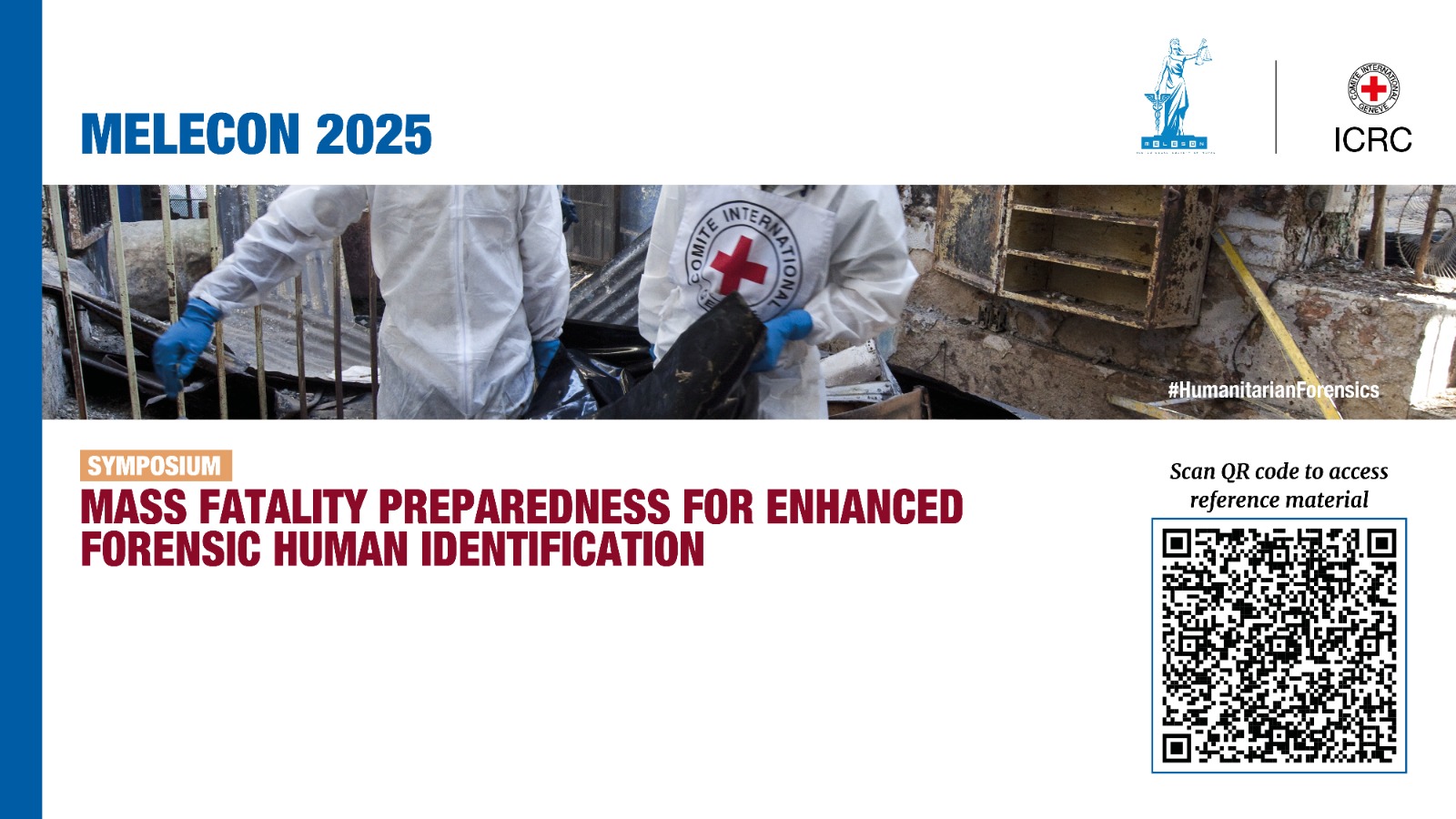ICRC Publications
- . Management of Dead Bodies after Disasters: A Field Manual for First Responders
- . The Forensic Human Identification Process: An Integrated Approach
- . Forensic Identification of Human Remains
- . The Recovery of Human Remains in Weapon-Contaminated Settings
- . Medicolegal Facilities – Guidelines for Architectural Programming and Construction Assistance
- . Guidelines for the use of Forensic Genetics in Investigations into Human Rights and International Humanitarian Law Violations
- . Guiding Principles for Dignified Management of the Dead in Humanitarian Emergencies and to Prevent them Becoming Missing Persons
- . Clarifying the fate and whereabouts of missing migrants: Exchanging information along migratory routes
- . A comprehensive web-based solution for managing information on missing persons and human remains
- . Restoring Family Links – Families Belong Together
- . Missing Persons: A Hidden Tragedy
- . Missing Migrants and their Families – The ICRC’s Recommendations to Policy-Makers
- . A Potential Contribution to Human Identification Using Peri-Mortem Trauma: An Example from Peru (2017)
- . Challenges in identification of dead migrants in the Mediterranean
- . Child trafficking and European migration crisis_The role of forensic practitioners
- . Ebola epidemic in Liberia and managing the dead_A future tole for Humanitarian Forensic Action
- . Ethical considerations for forensic scientists participating in humanitarian action_A personal reflection
- . Forensic aspects of the 2009 Victorian Bushfires Disaster
- . Grave mapping in support of the search for missing persons in conflict contexts
- .Humanitarian forensic action_Its origins and future
- .ICRC AM PM Database_Challenges in forensic data management in the humanitarian sphere
- . International Humanitarian Law_The legal framework for humanitarian forensic action
- .Large-scale forensic investigation into the missing_Challenges and considerations
- .Psychosocial approach in humanitarian forensic action_Latin American perspective
- . Recovery and identification of human remains in post-conflict environments
- . Sexual violence interventions_Considerations for humanitarian settings
- . The International Committee of the Red Cross and the protection of world war dead
- . The pathology of torture
- . Use of forensic DNA analysis in humanitarian forensic action_The development of a set of international standards
Reading material by resource persons
- . A dental perspective on the successes and limitations of DVI response to Nepal earthquake
- . Advancements and challenges in dental forensic for DVI
- . Analysis of smiling photograph; Operation US-Bangla Air Crash
- . Ante Mortem (yellow) INTERPOL DVI form (2018, fillable) – Missing person
- . Application of UV light in DVI of Avalanche Victims
- . Awarness and perception of an Indian dental professional in context to the process and their role in DVI as a taskmaster
- . Case report_operation makalu air crash_influence of cognitive and human factors on decision making
- . Challenges and technological solutions to theidentification of individuals in mass grave scenarios in the modern context
- . Challenges in identification of dead migrants in the Mediterranean
- . Child trafficking and European migration crisis_The role of forensic practitioners
- . Commingled human remains methods in recovery, analysis, and identification-annotated_Adams, Byrd – 2014
- . Ethical considerations for forensic scientists participating in humanitarian action_A personal reflection
- . Forensic Anthropology & most probable cause of death in cases of violations against IHL
- . Forensic Anthropology Research in East and Southeast Asia_Go et al. (2019)
- . Forensic aspects of the 2009 Victorian Bushfires Disaster
- . Forensic odontology in DVI_current practice and recent advances
- . Grave mapping in support of the search for missing persons in conflict contexts
- . Handbook of forensic anthropology and archaeology Blau, Ubelaker eds (2016)
- . Humanitarian forensic action_Its origins and future
- . ICRC AM PM Database_Challenges in forensic data management in the humanitarian sphere
- . Identification of deceased children of Nepal airlines crash through dental age estimation
- . Identifying, tracking, and reporting disaster-related deaths
- . Importance of dental records for victim identification following Indian ocean tsunami in Thailand
- . International Humanitarian Law_The legal framework for humanitarian forensic action
- . Interpol fact sheet_DVI
- . Interpol_DVI Guide 2023
- . Interpol_DVI Guide Annexure 1
- . Interpol_DVI Guide Annexure 3
- . Interpol_DVI Guide Annexure 4
- . Interpol_DVI Guide Annexure 5
- . Interpol_DVI Guide Annexure 6
- . Large-scale forensic investigation into the missing_Challenges and considerations
- . Mass Fatality Incidents A Guide for Human Forensic Identification
- . Mass fatality incidents_a guide for human forensic identification_NIJ special report
- . Psychosocial approach in humanitarian forensic action_Latin American perspective
- . Recovery and identification of human remains in post-conflict environments
- . Sexual violence interventions_Considerations for humanitarian settings
- . The Bournemouth Protocol on Mass Grave Protection & Investigation
- . The Contribution by (Forensic) Archaeologists to Human Rights Investigations of Mass Graves – K. Juhl
- . The International Committee of the Red Cross and the protection of world war dead
- . The pathology of torture
- . The role of forensic anthropology in DVI_recent developments and future prospects
- . The Role of Forensic Anthropology in the Examination of the Daegu Subway Disaster
- . Use of forensic DNA analysis in humanitarian forensic action_The development of a set of international standards



